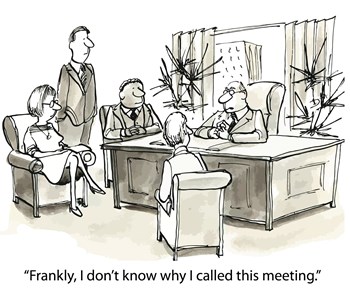
While the goal of any HOA board meeting is to determine the rules, regulations and property updates that best serve the interests of all the residents of a community, these meetings are often viewed as boring, long winded, and sometimes divisive. This can mean that little gets accomplished, despite the best efforts of the board and management. The proverbial can is kicked down the road, until the next frustrating round. But it doesn’t have to be this way. When a meeting is managed effectively, with sound communication practices and specific goals relevant to the collective needs of the association, success—in the form of a focused, purposeful gathering that yields concrete results while being respectful of the participants’ time—is absolutely possible.
First Things First
“First and foremost,” says Mark Durakovic, principal at the Chicago-based Kass Management Services, Inc., “it’s not about making meetings more appealing. It’s about making them less intimidating, and having residents know that their managing agent is there to do the heavy lifting and act as a consultant and advisor. Once they understand that, people are much more inclined to cooperate and participate,”
In most cases, Durakovic says this comes down to communication and education. And while certain board members might be more experienced simply from their longer tenure, newer residents might be overwhelmed by the prospect of even attending meetings, much less running for a board seat.
In Durakovic’s case, “Our more senior property managers will have our senior level staff meet with newer board members, and provide what could be considered a brief seminar on best practices—what it means to be on the board in each role, for example” he says. “A lot of times residents have reservations, and don’t want to get on the board because they don’t know what it means to be the secretary or what it means to be the treasurer or the president.” Understanding the purpose and duties of each role not only helps residents better understand who’s governing their building or HOA, but also helps demystify the meeting process a bit.
And the task of educating and supporting board members doesn’t end with just the management company. With the goal of ensuring board meetings are constructive and structured, Durakovic’s firm will often bring in outside consultants as well. “These third parties are typically legal counsel, reserve study specialists or lenders,” he says, “and whether it’s annual or bi-annual, they offer seminars to further educate the boards or potential board members.”
Keith Hales, president and CEO of the Chicago-based Hales Property Management, agrees with Durakovic on the efficacy of bringing in outside experts to educate and advise boards, but also notes that residents who just aren’t interested in attending or actively participating in board meetings normally have good reasons.
“We found that normally low attendance [at meetings] means that owners aren’t concerned with the overall governance of the association, or find meetings to be unproductive, boring, or even potentially hostile.”
One way to counteract this sense of detachment or trepidation is by “making sure the board is comfortable openly discussing the agenda items, getting more owners involved and being fully transparent,” Hales continues. “An example would be if an owner has a complaint about the hallway lighting”—rather than make a note of it and simply move on, “The board might ask that owner if they would like to head up a committee to upgrade the lights in the hallways.”
Offering residents the ability to form or join committees, as Hales notes, can often lead to better relationships between board members and residents as it takes some of the burden off the former, and gives the latter a stronger sense of ownership and direct involvement in the maintenance and running of their community.
“Depending on the size of the building, forming individual committees to assist with specific aspects of governance or maintenance can be very beneficial to both the owners and the board members,” Hales says.
“For example, a larger association may have a landscaping committee that oversees the design and maintenance of the association’s grounds,” he continues. “Through working on that committee, owners who may be concerned with the way the landscaping is done can now be directly involved in its overall management.”
Effective Communication Practices
Chicago-based management company FirstService Residential recently released a guide for boards entitled Connecting With Your Community: Communication Best Practices. The guide outlines four variables that are key to successful communication between board members and residents: channels, roles, process and support.
“People have different preferences for how they receive communications,” notes Judy Ziner, vice president of property management at FirstService, “so if the goal is to get information into the hands of boards and residents, you need to use every available method.” According to the guide, communication between board, management, and residents should be regular, and should be a two-way street; there should also be an established method for fact-checking all communications.
During meetings especially, sasy Ziner, “Residents need the opportunity to voice their concerns and share their opinions. Reserve time to openly discuss resident feedback during your virtual or in-person board meetings. Ensure that you regularly send out surveys to determine what’s important to residents and other board members. You may even want to set up listening sessions where residents can express their views to board members in a more casual setting. However, make it clear that the board can only act during board meetings, and only on items that are on the agenda.”
While it’s more an exception than the rule, one does occasionally hear about—and sometimes attend—board meetings that truly go off the rails and become unruly or openly hostile. Hales says this is often the result of a ‘surprise’ topic or issue being raised that is not on the agenda, and that the assembled board and residents aren’t prepared to discuss meaningfully.
This is why “setting expectations for how the meeting will be run beforehand is helpful,” he says, “especially if the board members suspect it may become contentious. If the meeting becomes hostile, end it immediately, and reschedule for another time.”
Do Your Homework
Preplanning agenda items is critical to a successful board meeting. Unfortunately, this is a lesson some boards learn the hard way, Hales explains.
“The old saying of, ‘If you fail to prepare, then prepare to fail”’ certainly applies,” he says. “Setting appropriate expectations and boundaries with our managers in addition to guiding them to make sure they have answers for all of the current issues as well as anticipating new issues is key.”
Hales notes that another important step a board should take is developing an agenda that imposes specific time constraints on each of the talking points.
“Prep board members on the decisions that need to be made at the meeting. Conduct board business in the beginning of the meeting, and then open up discussion topics toward the end,” he says. “Don’t let someone else take over the meeting.”
Durakovic, concurs, and adds that it is also important that board members and residents, regardless of the issue at hand, respect each other by not speaking over one another.
“Nobody should cut off someone mid-conversation, nor should anyone interrupt a discussion just to express their opinion,” he says. “These meetings are meant to address certain topics, and if that topic can’t be closed, then additional conversations can be scheduled.”
And while every association is different and deals with wide-ranging issues, such as capital improvement projects, Durakovic says in addition to allocating a specific amount of time for discussing each agenda item, setting—and sticking to—a time frame for the meeting as a whole also helps ensure a successful outcome.
“Generally, I don’t think any meeting should be scheduled for less than 60 minutes,” he says, “and anything longer than two and half hours, you’ll have people losing concentration—but it really all depends on your action and agenda items.”
FirstService’s report also stresses the importance of setting priorities and promoting transparency.
“Ideally, you want to inform board members and residents about everything that affects them. However, if you have limited time or resources, focus on high-priority items first, such as meeting notices, financial information and policy changes,” the report notes.
Transparency is not only needed between the board and residents, but also between board, residents, and the management company. Managers should have a reasonable level of autonomy in order to do their jobs efficiently. “The board should never be surprised that a property manager communicated to your residents without your knowledge,” says Ziner.
The Ombudsman
Even with best practices in place however, every board will inevitably encounter issues that aren’t easily resolved, or residents who are difficult or downright unruly during meetings. One of these issues—or worse, both at once—can cast an unnecessary shadow over a board-management team that is otherwise doing a good job for the association.
“Often the reason why meetings become contentious is owners’ lack of trust in the board and management,” Hales says. “Management can help to restore this by proactively communicating the issues early and clearly. This creates better transparency, as well as setting appropriate expectations with the rest of the owners.”
Sometimes issues specific to one or more residents may require private resolution, Durakovic notes. “In most cases, these are issues related to fines and penalties levied on residents who are in arrears, or who have had numerous complaints due to noise, smoking, or the like.” In these cases, he says these issues are most often—and most appropriately—handled in a private hearing with just the board and the resident in question present.
Durakovic has been in the industry for 22 years, and says that 10 years ago, there was actually more conflict between residents and boards. However, due in part to the pandemic and the ability to attend meetings virtually, he says more residents have a better understanding of what boards are trying to accomplish, and are often less inclined to make unnecessary waves.
“Virtual meeting devices can present their own challenges,” he says, “but one of the positives with virtual meetings is that they’ve made it more convenient for board members and residents to participate—so meeting attendance has increased. The goal is to communicate clearly, and avoid conflict. It all comes down to common courtesy, and sometimes we all need a friendly reminder about that.”
W B King is a freelance writer and contributor to CooperatorNews.









Leave a Comment